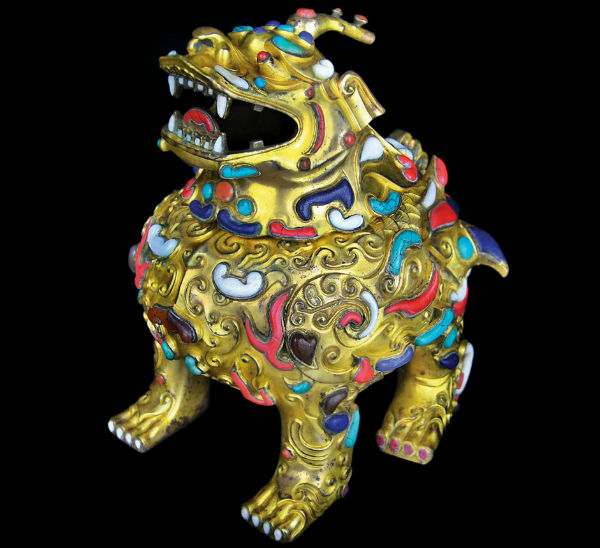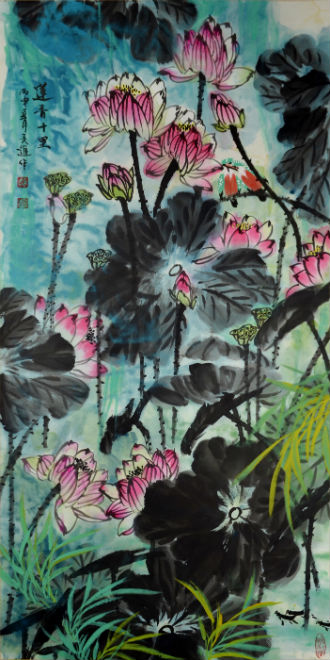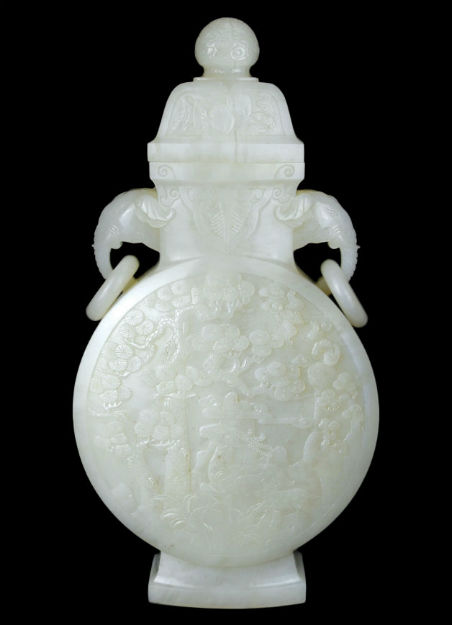Luduan censer first of many highlights at Gianguan sale Sept. 9

NEW YORK – On Monday, Sept. 9, Gianguan Auctions will celebrate the 17th running of its annual fall sale. Dovetailing with Asian Art Week, the auction offers fine paintings, carved jades, ceramics, teapots and religious items rich in aesthetics and craftsmanship. This year works by early 21st century Chinese avant-garde artists working the traditional manner will be included. Bid absentee or live online through LiveAuctioneers.
Sale highlights begin with the cover lot, a fine gilt bronze censer in the form of ferocious luduan (above), incised and further decorated with a tootie mask of coral, lapis, jade, malachite and glass. A favorite of Qing emperors, luduan were said to detect truth. This fabulous animal has all the hallmarks of its station: sharp-clawed hooves, bulging eyes, fanged teeth and a single horn. This lavish expression of royal protection is Lot 75, of the Qianlong period, and valued at more than $60,000.
Symbolic imagery overflows onto a dragon encrusted, gilt-incised and painted lacquer box (below). The five-clawed beasts of royalty appear in all guises from a commanding frontal facing dragon centered among four in flight to four confronting pair on the outer box. They allude to the desire for longevity that, in the case of emperors, was to realize five generations within his household. (Most emperors died in their 40s.) Enhanced with scrolling gold Tiangi leaves, florals of blue, red and brown, a “Wan” diaper ground, and key fret pattern, the box is in excellent condition for its age. Lot 107 is 20 inches (52.7 cm) tall. It bears the Qianlong six-character mark and is of the period. The estimate is upward of $20,000.

The importance of even the most mundane creatures of the natural world comes to light in Leaves and Insects by Qi Baishi (1864-1957). Caterpillar, dragonfly, butterfly and ant take on detailing and density that renders them important players in a two-panel scene featuring skeletal brown branches and leaves of ochre and green. Inscribed and signed Qi Baishi, with two artist seals on each panel, the bidding on Lot 83 begins at $300,000.

There are six more works by Qi Baishi in the sale. Estimates begin just shy of $100,000.
The focus then turns to other 20th century Chinese innovators, including Xu Beihong. Roaring Lions (1938), depicts two pairs atop outcroppings, while an open-mouthed beast in three-quarter profile takes center stage. Lions are generally symbolic of power. Lot 86 is inscribed and signed Beihong, with two artist seals (estimate on request).
Two works by Li Keran, splashed line drawings of young shepherds tending hulking water buffalo capture the interplay between man and beast. They are Lot 136, Young Herders and Cricket, and Lot 111, A Shepherd. Both carry moderate estimates of $60,000 or above.
The contemporary art collection leads with Lotus by Zhang Xiujin (b. 1951). Admiring Lotus (2016), one can see other paintings implied within the overall context. The muddy, weedy ground from which rise a turquoise mist and brilliantly colored flowers straining against their hard-edged outlines is the sort of visual poetry one expects from Zhang Xiujin. She has been awarded many honors including “Chinese Charity Artist” by the China Charity Federation. It is anticipated that Lot 62 will exceed its low estimate of $150,000.

Masterworks from the past include Crane and Pine by Qing artist Hua Yan (Xinluo Shanren). The energetic rendering of nesting cranes in evergreen brings forth references to both longevity and wisdom. Executed realistically with precise brush strokes, the painting retains its vibrancy of color. Lot 169, inscribed and signed Hua Yan, with two artist seals and two collectors’ seals, is an admirable acquisition at $30,000 or higher.
A highlight of the ceramics collection is a sancai vase of ovoid form animated with swooping red phoenixes and leaping dragons. The bright color portends good fortune and joy. The background of intertwined peonies and chrysanthemum is rendered in green and yellow with dashes of red. Finished with bands of red with white flowers at the shoulder and garlic-form mouth, Lot 162 is 18 inches tall and expected to go off at $60,000 or more.
Also, Ming is a pair of sacrificial red glazed bottle vases. The color often graced Imperial wares of the Yongle period. On these well-potted examples, color fades to white at the rim. Lot 177, 20 inches tall, has a starting bid of $15,000.
Amid a deep collection of famille rose enameled items, two delightful and easily accessible items stand out. A copper hand warmer (2½ inches tall) with a yellow ground is overglazed with elaborate phoenixes of blue, red and green, and bordered by green plantains. The cover is pierced with a diapered ground of geometric coins, bordered with floral scrolls. With the Yongzhen two-character mark, it is of the Period. Lot 141 opens at $3,000. Following is a famille rose enameled three-abundances water pot painted with the auspicious Sanduo symbols of peach, pomegranate and finger citron, all on a turquoise ground. Lot 142 carries the Yongzheng four-character mark within double squares and is of the period. It is a treasure at $5,000.
Leading the stone carvings is a white jade moon flask with cover and elephant head handles with rings. The moon windows on obverse and reverse of this outstanding flask are elaborately carved with pairs of bats, deer, and cranes amid bamboo, lingzhi, rock outcroppings, pine trees and clouds. Traditionally such work imparts blessings of Fu Lu Shou Quan-zhiyouquan, doubled happiness, wealth and longevity simultaneously. Lot 114 is 13 inches high and is well valued at upward of $80,000.

The maker of a Warring States zun of semi-transparent greenish-brown jade called on all the mythical animals to create this ritual item. While the cylindrical body is in low relief with Kui dragon motifs and geometric scrolls separated by notched flanges, there is drama in the cover, handles and feet. A recumbent bixie is at the knop, while elongated bixie scale the sides to form handles. The tripod feet are recumbent mythical beasts. Modeled after a ritual bronze vessel, Lot 120 is 10½ inches tall, weighs in at more than 4,000 grams, and carries an opening bid of $40,000. It leads a collection of archaistic carvings that can be seen in the auction catalog.
The square turquoise seal of General Wei De kicks off a collection of stone seals. With dragon masks on the base and a pierced qilin knob, the script characters are Gui De Wei Yin. Lot 44 starts at $50,000.
Classic and quixotic Zisha teapots, a favorite of collectors, include Chao Daheng’s Yixing Zisha pot with a monk’s cap cover. It carries the Shao Daheng mark on the base. The opening bid for Lot 218 is $600. A Jiang Rong yellow glazed melon form Zisha teapot has a cicada knop, green glazed spout and a handle that culminates in a low relief leave. It is Lot 220. Lot 221 is the mirror image in a green glaze with brown decorations. Both are signed and start at $800.
Not to be overlooked is the collection of fine jade jewelry that opens the sale.
The Monday, Sept. 9 sale begins at 6 p.m Eastern Time. Inquiries are being accepted at 212-867-7288 and 212-867-9388; email: [email protected]









